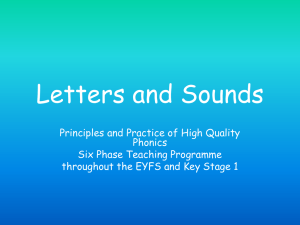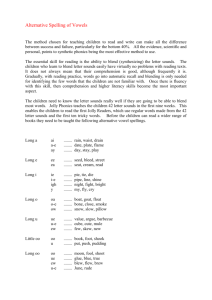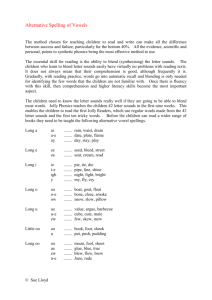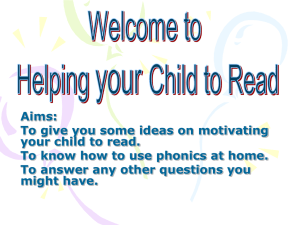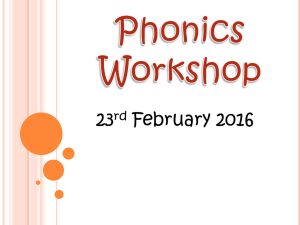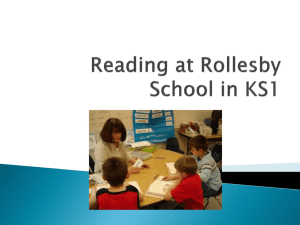Jolly Phonics - St John the Baptist BNS, Cashel, County Tipperary
advertisement
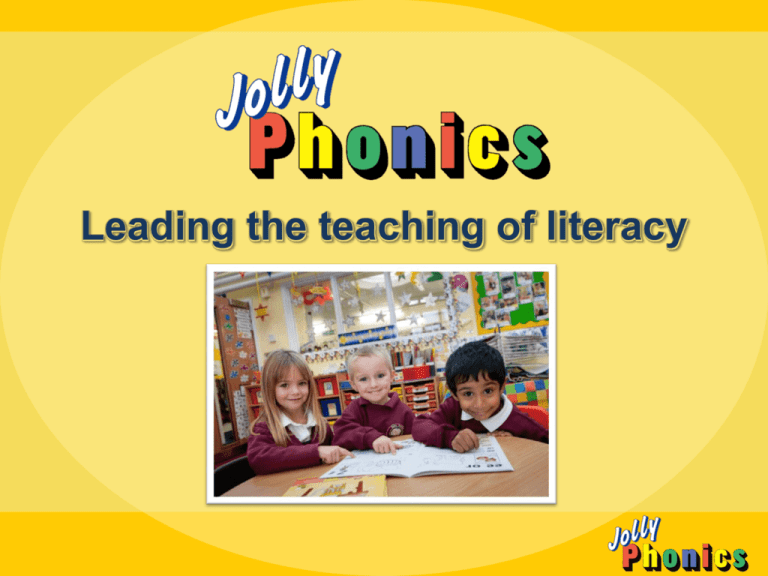
Leading the teaching of literacy A comprehensive programme for reading and writing 2 Research The Jolly Phonics’ children’s reading skills were 11 months above the level expected for their age. We found that the boys did as well as the girls. In the Jolly Phonics group the ‘tail’ of low achievement in writing was simply abolished. 3 An integrated programme that grows with the children 4 Storybooks Reading books to children gives them: • • • A love of books A wider vocabulary A greater understanding of language But the children need to ‘crack the code’ of English to become independent readers. 5 The 5 Basic Skills The 5 basic skills of Jolly Phonics are: 1. 2. 3. 4. 5. Learning the letter sounds Learning letter formation Blending Identifying sounds in words Tricky words 6 Letter Sounds Children learn in a fun, multi-sensory way using stories and actions. Learning the action for the /s/ sound: Weave your hand like a snake, making an ‘s’ shape, saying sssssssss. 1. Learning the letter sounds 7 Letter Sounds 1. Learning the letter sounds 8 Digraphs Digraphs are two letters that make one sound. 1. Learning the letter sounds 9 Alternative Spellings The alternative spellings of the vowel sounds: Introduced as: Taught later as: (rain) (play) (flame) (feet) (leaf) (these) (boat) (snow) (bone) 1. Learning the letter sounds 10 Letter Formation Correct formation can be encouraged from the very beginning: • • • 2. Learning the letter formation 11 Feel the letter formation See the letter formation Write the letter in the air Pencil Hold The children need to learn how to hold their pencil properly right from the start: • • 2. Learning the letter formation 12 ‘Tripod’ grip ‘Froggy legs’ movement Blending Skills Blending skills are essential for reading. They can be taught right from the start. 3. Blending 13 Blending Words The number of regular words for blending grows with each new letter sound: Jolly Phonics Word Book 3. Blending Word Boxes 14 Blending Activities Blending activities can be fun and multi-sensory: • • • Random letters ‘Miming’ words Read and See books s n 3. Blending 15 c p t a e i Blending Harder Words Regular practice is the key to blending words with digraphs and consonant blends: Digraphs Word Boxes 3. Blending 16 Phonological Awareness Phonological awareness can be encouraged from the very first lesson: 4. Identifying sounds in words 17 Hearing the Sounds Lots of practice is needed before children can identify all the sounds in words: • • • • 4. Identifying sounds in words 18 Sounding out words Word families Removing the first sound Chopping game Dictation Dictation practice prepares the children for independent writing: • • • • • 4. Identifying sounds in words 19 Letter sounds Simple CVC words Regular words with consonant blends and digraphs Phrases and sentences Capital letters Simple Dictation A sample of early dictation by a five-year-old using Jolly Phonics. 4. Identifying sounds in words 20 Independent Writing For children to write independently they need to know: • • • • The 42 letter sounds How to hear the sounds in words One way of writing the letter sounds What they want to say 4. Identifying sounds in words 21 Independent Writing Independent writing towards the end of the first year: 4. Identifying sounds in words 22 Tricky Words To read tricky words well, the children need to: • • 5. Tricky words 23 Work out the ‘tricky’ bits Have regular flashcard practice Tricky Words To write tricky words well, the children need to learn the following techniques: • • • • 5. Tricky words 24 Look, copy, cover, write and check Say it as it sounds Mnemonics: ‘o u lucky duck!’ Word families Tricky Words ‘Look, copy, cover, write and check’ is a good way to learn how to write tricky words. (Click image to play animation) 5. Tricky words 25 Jolly Phonics Readers A wealth of interesting, decodable texts 26 Jolly Phonics Readers Variety of interesting and engaging stories in decodable language Guidance for teachers and parents, including comprehension questions Guide to the letter sounds and tricky words needed for each book Level 1: Red Readers 27 Jolly Phonics Readers 28 Parental Support Providing additional support at home can help children achieve the best results: • • • • • 29 Sound sheets Sound books Word boxes Dictation Jolly Phonics Readers First Year Timetable First term Second term Third term 1 Teach the 42 sounds Introduce letter names Teach alternative spellings Revise alternative spellings 2 Teach how to form the letters correctly Teach handwriting rules and give writing practice Give handwriting practice 3 Teach how to blend simple regular words Introduce the Readers Practice blending words with alternative spellings Continue with Jolly Readers and blending practice 4 Teach how to write words by listening for sounds Give regular dictation of words and sentences Continue regular dictation Encourage independent writing 5 Teach how to read and write the first set of tricky words Teach the reading and writing of more tricky words Ensure the children know the first 60 tricky words 30 First Year Checklist Knows sounds Blends regular words with these sounds Writes regular words with these sounds s a t i p n ai j oa ie ee or ay ea igh ow ew Knows sound Knows name Forms correctly Alphabet: lower case letters Alphabet: capital letters Sings/ Recites Knows Alphabet order 1-10 Able to read tricky words Able to spell tricky words 11-20 21-30 31 31-40 41-50 51-60 Leading the teaching of literacy Systematic approach Fun, multisensory teaching Range of age-appropriate materials 7 years’ literacy teaching Enables confident, independent learning Print or Precursive Jolly Phonics materials are available in both precursive and print letters: Precursive letters have joining tails to encourage cursive writing. Print letters are standard letters, without joining tails. 33

